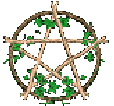|
|
|

|
|


~ Webmaster's Comments ~
The two main streams of "British Paganism are Wicca and Druidry. Although both traditions draw their inspiration from past ages, much of their contemporary practice has evolved very recently - from the eighteenth century for Druidry, from the 1940s onwards for Wicca. The eighteenth century saw the development of Druid ceremony, much of it articulated by Iolo Morganwg, and in the twentieth century the MacGregor-Reids and Ross Nichols gave further inspiration and form to Druid ceremony and thought, while Gerald Gardner proved the catalyst for the rebirth (or birth, depending on your opinion) of Wicca. Since Wicca and Druidry share so much in common, it is natural to wonder whether they were originally one and the same, only developing later in different directions. Gerald Gardner, in The Meaning of Witchcraft (1959) wrote "The great question is, were the witches and the Druids members of the same cult?.....Personally, I think they were not; the witch cult was the religion of the soil, as it were, and the Druids were the more aristocratic religion..." At a Pagan Federation conference and then later in The Druid Way (1993) I asked Gardner's question again, and quoted various authors views on the subject.
Christina Oakley's article continues the debate, and her conclusion tallies with Gardner's: Wicca and Druidry have different histories. They certainly "feel" different, as Christina Oakley mentions, and I think our Paganism is all the richer for these two vital, distinct and rich traditions growing side by side. Many people, however, are now following both paths, combining them idiosyncratically to suit their own tastes and practises, in the time-honoured slightly anarchical way of modern Paganism. There is value in this, but also, I believe, a danger. The value lies in our being able to develop our own unique path. Paganism, Wicca, Druidry, Shamanism, the Earth Religions - all avoid the problems of the Revealed Religions, which so easily develop into personality cults and dogmatic systems. The eclecticism and anarchy of the former prevent this. And so a creative meeting of Wicca and Druidry is occurring, with some people feeling that the private focus of Wicca fulfils one need, while the more public focus of Druidry fulfils another.
Christina Oakley says 'At the heart of Wicca is the image of the God and Goddess joined in love as one'. Whilst variants of Wicca do not make the Great Rite central, she is speaking here of Traditional British Wicca, whose focus is on the act of union, just as Druidry's focus is on the results of that act: symbolized by the Divine Child, the Mabon, and expressed through the Arts and the Bardic tradition. Thus, the emphasis on the joining of male and female energy in Wicca seems perfectly balanced with the emphasis on the results of that joining in Druidry. So we can see that it is quite possible to follow both Wicca and Druidry, since each fulfils a different need and helps to express a different facet of the self. To return to Gerald Gardner's suggestion, we could say that now we can embrace both traditions because socially we are no longer so constrained, and the person of the soil and the person of culture both need feeding within us. Having said this, it is important to realize the limitations of this argument, since many Wiccans and Druids will quite rightly point to the completeness of their own tradition, which belies any necessity for combination with a complementary path. Even so, the mixing is undoubtedly happening. If you were to visit a non-aligned Pagan ceremony at a festival time, you would almost certainly find yourself participating in a ritual which draws its inspiration and form partly from Wicca and partly from Druidry. Ask Wiccans if they are Druids too, and a good deal will say they are, and vice versa. The question is, are we enriching our traditions or diluting them?
While some contemporary Pagans eclectically blend Wiccan and Druid practice, research is revealing more of the connections that existed in the seminal years of modern Druidry's and Wicca's development - the 1940's and 50's. The influence of the related movements of Woodcraft Chivalry and Naturism of the 20's and 30's, which could be seen as effectively Pagan movements, is only now being explored (see Ronald Hutton's article in Enchante Autumn 1993 and Steve Wilson's article in Aisling 8 (1995)). Both Gerald Gardner and Ross Nichols, founder of the Order of Bards Ovates & Druids, were influenced by these, and we know that Gardner was a member of the Ancient Druid Order (The Druid Way p.57). It has also been suggested that George Watson MacGregor-Reid, Chief of the Ancient Druid Order, was also a member of the famous New Forest coven in 1939 (W.E.Liddell The Pickingill Papers, Capall Bann 1994 ). From conversations with Ross Nichols, and from his writings, I believe that he was probably not an initiated Wiccan (although I cannot be certain of this), but I know that he was highly sympathetic to Wicca and had many Wiccan friends, including Justine Glass, author of Witchcraft, the Sixth Sense and Us (Neville Spearman 1965) and apparently Doreen Valiente. Gardner and Nichols were friends too, and as a result of their exchanges the eightfold Pagan festival cycle was born. (Or reborn, depending on your point of view. For a discussion of the history of this central feature of modern Pagan practice see Steve Wilson's article in Aisling 8 (1995) p.15 which is based partly on detailed research by Ronald Hutton for his forthcoming book on the history of modern paganism The Triumph of the Moon.) Following their discussions, Wiccans incorporated the Solstices and Equinoxes into their celebrations, and Druids incorporated the fire festivals into theirs. That is a tremendous example of cross-fertilization between the two traditions, and in the last few years we have seen this happening in a wider, though less dramatic form.
I believe we can avoid a dilution or homogenization by understanding Druidry and Wicca as two discrete, separate entities, which nevertheless have much to offer each other. Some will want to work in both traditions, feeling that they complement and enrich each other. Others will prefer to root themselves firmly in just one tradition, sensing that it is complete in itself.
![]()
![]()